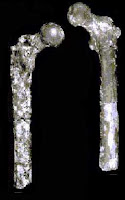Thursday, July 08, 2010
A Chinese Ape in Our Ancestry? Part 2
In an earlier post I reported on the basicranium of Lufengpithecus lufengensis as described in a 2008 monograph. The basicranium illustrated comes from the crushed male cranium of specimen PA 644. There are also complete but crushed basicrania of a juvenile specimen PA 844 (left) and a female specimen PA 677 (right). These can be seen in the following plates, but they haven’t been configured in a fashion to make their traits readily discernible and they haven’t been described in detail, so its very difficult to confirm the placement of the foramen magnum as in PA 644. Nonetheless, there is more than enough morphology present to eventually allow for a computer assisted reconstruction of both specimens.
There is, however, another specimen that comes into play that has not received the attention that is warranted. It is a well-preserved male left proximal femur (PA 1276) that is configured in the 2008 monograph. On first glance it looks remarkably similar to the proximal femur of Orrorin which has been put forth as conclusive evidence for bipedalism and hominid (s.s) status in that taxon. Below is a comparison of the L. lufengensis proximal femur (left) and Orrorin's (right).
Without going into too great detail I will quote from the conclusion reached in the English summary of the 2008 monograph, "the complex contour of the femoral head and neck of the Lufengpithecus femur is similar to those of Australopithecus and early Homo, and differs distinctly from the mushroom shape seen in modern apes." Furthermore, "The position of the fovea capitis of the Lufengpithecus femur is markedly different from that of modern apes." and "In the Lufengpithecus femur...the degree of development of the fovea capitis and its location are similar to those of early and late Australopithecus." In addition, "the degree of development of the intertrochantic crest of the Lufengpithecus femur nears that of the late Australopithecus femur KNM-ER 738." The monograph has much more to say about this femoral specimen, but I hope this cursory introduction leaves the reader with the impression that the Orrorin femur is not nearly as hominid-like as previously stated or, on the other hand, the L. lufengensis femur is equally hominid-like. Coupled with the evidence from the basicranium presented in my previous post Lufengpithecus is looking more and more interesting as a potential protohominid (s.s.). Below are line drawings comparing the Lufengpithecus femur to a number of ape and hominid (s.s.) femora.
Next I'll review a suite of craniofacial traits that show Lufengpithecus to be more African ape-like than Asian ape-like.






